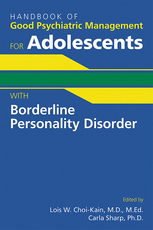Handbook of Good Psychiatric Management for Borderline Personality Disorder
View Pricing
Description
The diagnosis and treatment of patients with BPD can be fraught with anxiety, uncertainty, and complexity. How welcome, then, is the Handbook of Good Psychiatric Management for Borderline Personality Disorder, which teaches clinicians what to do and how to do it, as well as what not to do and how to avoid it. The author, a renowned researcher and clinician, has developed a new evidence-based treatment, Good Psychiatric Management (GPM) that comfortably utilizes cognitive, behavioral, and psychodynamic interventions that are practical and simple to implement. Because psychoeducation is an important component of GPM, the book teaches clinicians how to educate their patients about BPD, including the role of genetics and the expected course of the disease. This approach offers advantages both to practitioners, who become more adept at honest communication, and to patients, who are encouraged to have realistic hopes and to focus on strategies for coping with BPD in daily life.
The book is structured for maximum learning, convenience, and utility, with an impressive array of features.
- Section I provides background on BPD, including the myths that sometimes discourage clinicians from treating these patients and that hamper the effective treatment of the disorder.
- Section II, the GPM Manual, provides a condensed and clear description of the most essential and specific GPM interventions that clinicians can learn from and use in everyday practice.
- Section III, the GPM Workbook, offers case vignettes which reference chapters from the manual. Each vignette has a number of decision points where alternative interventions are proposed and discussed.
- To further facilitate learning, a set of nine interactions is found in a series of online video demonstrations. Here, readers can see in vivo illustrations of the GPM model in practice.
- Finally, a set of appendices provides critical information, such as a comparison of GPM with other evidence-based treatments of BPD, scaling risk and response strategies, and family guidelines.
Designed to be a basic case management text for all hospital, outpatient clinic, or office-based psychiatrists or mental health professionals who assume primary responsibility for the treatment of those with BPD, the Handbook of Good Psychiatric Management for Borderline Personality Disorder constitutes a breakthrough in the treatment of these often misunderstood patients.
Contents
- Preface
- Acknowledgements
- Section I: Background
- Chapter 1. Introduction to good psychiatric management (GPM)
- Section II: GPM manual: Treatment Guidelines
- Chapter 2. Overall principles
- Chapter 3. Making the diagnosis
- Chapter 4. Getting started
- Chapter 5. Managing suicidality and nonsuicidal self-harm
- Chapter 6. Pharmacotherapy and comorbidity
- Chapter 7. Split treatments
- Section III: GPM Workbook: Case Illustrations
- Chapter 8. Case illustrations
- Section IV: GPM Video Guide: Demonstrations of the Approach
- Chapter 9. Video demonstrations
- Appendix A: Relation of GPM to other evidence-based treatments for BPD
- Appendix B: Common features of evidence-based treatments for BPD
- Appendix C: Safety Planning: An Example
- Appendix D: Guidelines for Families
- References
- Index
About the Authors
John G. Gunderson, M.D., is Professor of Psychiatry, Harvard Medical School, and Director, BPD Center for Treatment, Research and Training, McLean Hospital, Belmont, Massachusetts.
Paul Links, M.D., M.Sc., F.R.C.P.C., is Professor and Chair, Department of Psychiatry, Schulich School of Medicine and Dentistry, The University of Western Ontario, and Chief of Psychiatry, London Health Sciences Centre and St. Joseph's Health Care, London, Ontario.
Related Products
Carousel Control - items will scroll by tabbing through them, otherwise arrows can be used to scroll one item at a time








